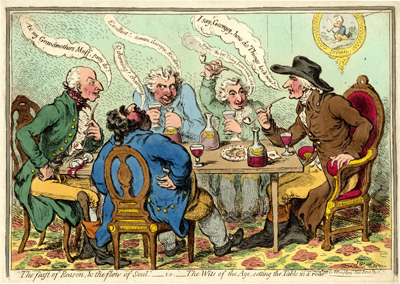The Feast of Reason, & the Flow of Soul. . .
The Feast of Reason. . . shows five notable Whigs siting at a table engaged in what can only very broadly be described as conversation. They include (from left to right) George Hanger, the longtime carousing companion of the Prince of Wales, with spilled glass and his trademark bludgeon in his boot, Charles James Fox, the Whig opposition leader (with his back to us), Richard Brinsley Sheridan, playwright, ardent Whig, and perennial debtor, looking (as usual in Gillray's prints) furtive and unreliable, the diminutive Michael Angelo Taylor, Member of Parliament, Whig supporter, and frequent subject in Gillray's prints after 1793, and finally John Courtenay, a sarcastic speaker in Parliament, and member of both the Whig Club and Brooks's.

© Trustgees of the British Museum
The full title of this print is "The Feast of Reason, & the Flow of Soul,"-i.e.-the Wits of the Age, Setting the Table in a Roar." The first part of the title alludes to lines from Pope, Imitations of Horace, II.1 and the second, to Hamlet, Act V, Scene 1. Both serve to contrast the sorry state of the present day (and the feeble offerings supposed to pass for wit) with a finer, richer past.
The allusion to Hamlet is to the scene in the graveyard when Hamlet holds the skull of Yorick and fondly remembers Yorick's gibes, his gambols, his flashes of merriment "that were wont to set the table on a roar."
The allusion to Pope comes near the end of the poem when Pope defends the independence of his satire: "To Virtue only and her friends a friend," and prides himself on a retreat that only
the best companions grace
Chiefs out of war, and Statesmen out of place.
There St. John mingles with my friendly bowl,
The Feast of Reason and the Flow of soul. . .
The chiefs out of war and statesmen out of place in this print, Gillray suggests, are a pathetic lot in comparison to Pope's St John. Even Juvenal, the Roman satirist, is reduced to a monkey with a pipe in the framed picture behind them.
But in contrasting the feeble opposition of his day to the wits and satirists past Gillray's print becomes almost a wish for a stronger, more capable opposition voice. And if anyone cared to read the rest of Pope's defence of satire, he couldn't help but reflect that the best Georgian analogue to Pope's devastatingly witty and highly personalized satire of individuals is Gillray's own.
Sources and Reading
- Commentary from the British Museum on The Feast of Reason, & the Flow of Soul. . .
- Draper Hill, The Satirical Etchings of James Gillray, 1976, #48
- "George Hanger, 4th Baron Coleraine," Wikipedia
- "John Courtenay," The History of Parliament
- "Michael Angelo Taylor," The History of Parliament
Comments & Corrections
NOTE: Comments and/or corrections are always appreciated. To make that easier, I have included a form below that you can use. I promise never to share any of the info provided without your express permission.